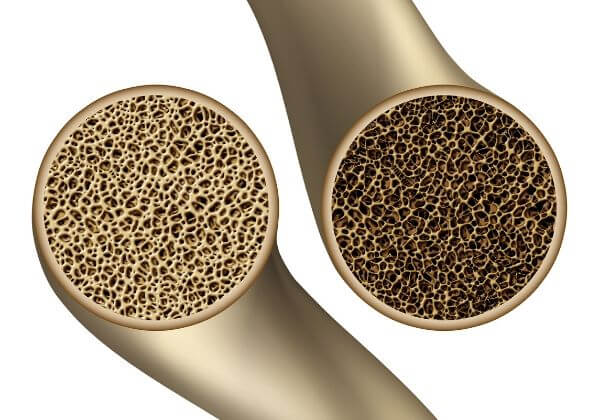Osteomalacia is a condition characterized by weakened bones. It develops when there are issues or problems with bone formation and bone-building.
Osteomalacia is commonly confused with osteoporosis as both involve weak bones, but the two conditions are different. Osteoporosis is the weakening of bones that have already been formed, and osteomalacia affects bones as they are forming.
What Causes Osteomalacia?
Osteomalacia causes your bone to weaken as they develop, and the main cause of this is a lack of vitamin D. Vitamin D is essential for absorbing calcium, which is an important mineral for healthy bone development.
A lack of vitamin D can also result from little to no sun exposure as the sun’s rays allow the vitamin to be made in the skin. You may also have issues absorbing vitamin D from your food due to any of the following conditions:
♦ Celiac disease, which damages the lining of your intestine interfering with nutrient absorption
♦ Kidney or liver disorders, which interfere with vitamin D metabolism
♦ Certain types of cancer can interfere with vitamin D processing
Osteomalacia Symptoms
The most common symptom for osteomalacia is bones that easily fracture. You may also notice weak muscles, especially in muscles that are attached to weakened bones. As a result, individuals may walk with a waddle.

It is also common for individuals with osteomalacia to experience bone pain in their hips that can spread to their pelvis, legs, and ribs. A lack of vitamin D and calcium can also cause additional symptoms:
♦ Numbness around the mouth
♦ Numbness in the extremities
♦ Irregular heartbeat
♦ Spasms in the hands and feet
Osteomalacia Diagnosis
Your doctor will need to run a blood test to diagnose osteomalacia. This testing will specifically look for low vitamin D, calcium, and phosphorus levels. Additional testing for alkaline phosphate isoenzymes can also be done, as high levels of these indicate osteomalacia.
X-rays and imaging may also be done to identify small cracks in the bones that can eventually develop into fractures. In some cases, a biopsy may also need to be done to confirm a diagnosis. For a biopsy, a small tissue sample is taken to check the health of the bone.
Treatment for Osteomalacia
When osteomalacia is detected early, calcium and vitamin D supplements can be provided to help prevent the worsening of the condition. Vitamin D injections may be necessary for individuals that have digestive issues that cause malabsorption.
If underlying conditions such as kidney or liver damage are causing the poor metabolism of vitamin D, then these issues will need to be treated first. Once underlying conditions are treated, vitamin D supplements can help the healing process for your bones.
You can also be given a brace to wear to help reduce bone irregularities.

Osteomalacia Diet
There is no diet that can cure osteomalacia, but a diet rich in vitamin D can help prevent the progression and ease symptoms. Diets low in vitamin D and calcium increase the risk of developing osteomalacia and severe bone damage.
To increase your dietary intake of vitamin D and calcium, be sure to eat the following foods:
♦ Greens, such as spinach, kale, and collards
♦ White beans
♦ Fish, such as salmon, trout, tuna, and sardines
♦ Fortified cereals and grains
♦ Cheese
♦ Egg yolks
Natural Treatments for Osteomalacia
The best natural treatment for osteomalacia is vitamin D. Your doctor will often prescribe this as the first treatment option, and daily supplements can help reduce bone cracks and fractures. When combined with phosphorus and calcium supplements, your overall bone health can improve.
You can also naturally increase your vitamin D levels by spending more time in the sun. Getting additional sun exposure will boost vitamin D levels that can protect your bones.
Osteomalacia Statistics
♦ The incidence of osteomalacia is about 1 in 1000 people.
♦ Almost 15 percent of the world’s population is vitamin D deficient.
♦ It can take up to six months for bones to fully heal after treatment begins.
♦ Osteomalacia affects 1 in every 2000,000 children.
Osteomalacia and Disability
While osteomalacia is treatable, if left untreated, bone deformities can be severe. If this happens, the pain and lack of mobility can be debilitating. The worse the condition gets, the more at risk you are for severe fractures, which can keep you from daily activities.

As you get older, these fractures also take longer to heal. To avoid any disability from osteomalacia, it is important to seek medical help as soon as you suspect that you may have the condition.
Osteomalacia in Children
When osteomalacia occurs in children, the condition is known as rickets. A lack of vitamin D is the cause, but the condition in children is more severe.
Growth and development are significantly impacted by osteomalacia, and children can develop bowed legs, severe spinal pain, and delayed growth. It is common for children with osteomalacia to develop skull, chest, and rib deformities. Treatment for children involves vitamin supplements as well as medications, and in severe cases, surgery.
What Is the Long-Term Outlook?
Osteomalacia can lead to several fractures and broken bones, and if not treated, severe bone deformities can develop. Early detection and treatment are necessary steps in preventing these frequent fractures and deformities.
Once calcium and vitamin D levels are high again, you should notice improvements right away, but complete bone healing can take up to six months. If you suspect that you may have osteomalacia, get tested early to protect your bones.






